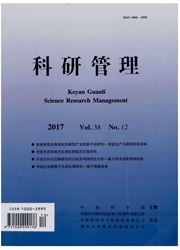

 中文摘要:
中文摘要:
本文运用湖南省1998-2007年新成立的54573家注册资本在1000万以下的工业中小企业数据具体分析了我国中小企业的生存状况及影响因素。主要的研究方法为生命表方法和加速失效时间模型等生存分析方法。研究主要发现:我国湖南省地区中小企业死亡危险随时间呈"U"型关系,企业在成立9.5年左右时死亡危险开始增大;企业原始规模、企业所在行业的行业规模以及工业增加值率、销售利润率与产值利税率三个效率指标都与企业生存存在显著的正向相关关系;但行业成长、流动资金周转率和全员劳动生产率与企业生存不存在显著的相关关系;垄断企业的生存状况更好,技术密集型中小企业的生存状况较差,区域集聚地区中小企业具有更大的死亡危险;利率对中小企业生存存在显著的负向影响,而基于城市层面的GDP增长率对中小企业生存存在显著的正向影响;相对于私营企业,湖南省地区内资企业和外资企业的生存表现更差。
 英文摘要:
英文摘要:
A detailed analysis on the Small and Medium sized Enterprises(SMEs) survival and its determinants are conducted,based on a sample of 54,573 new-registered industrial SMEs in Hunan Province,whichs capitals are all below 10 million Yuan and establish during the period of 1998-2007.The main research methods used are life table method and accelerated failure time model,they are mostly used in the survival analysis.The empirical results show that the risk of enterprise death follows a U-shape pattern relationship with the time for SMEs in Hunan Province,and the death risk begins to increase after nine and half years since the establishment of enterprises.The indicators,such as the original size of enterprises,industrial sector size,industrial added value rate,sales margin and profit tax rate of output value,all have significant positive impacts on business survival.However,the industry growth,liquidity capital turnover rate,and all-personnel labor productivity have no significant correlation with the business survival;Monopoly enterprises have better living conditions,the SMEs with high intensive technology have worse living conditions,SMEs located in agglomerate regions have greater risk of death.The interest rate has a significant negative impact on the survival of SMEs.While the GDP growth rate based on the city-level has a significant positive impact on the survival of SMEs.Vis-à-vis private enterprises,the survival performance of state-owned enterprises and foreign-funded enterprises in Hunan Province are even worse.
 同期刊论文项目
同期刊论文项目
 同项目期刊论文
同项目期刊论文
 MCELCCh-FDP: Financial distress prediction with classifier ensembles based on firm life cycle and Ch
MCELCCh-FDP: Financial distress prediction with classifier ensembles based on firm life cycle and Ch An agent-based simulation model of enterprises financial distress for the enterprise of different li
An agent-based simulation model of enterprises financial distress for the enterprise of different li Ownership concentration, ownership control and enterprise performance: Based on the perspective of e
Ownership concentration, ownership control and enterprise performance: Based on the perspective of e Aggregating multiple classification results using Choquet integral for financial distress early warn
Aggregating multiple classification results using Choquet integral for financial distress early warn The survival conditions of SMEs of Guangdong: an empirical research under the global economic crisis
The survival conditions of SMEs of Guangdong: an empirical research under the global economic crisis Evaluating branch efficiency of a Taiwanese bank using data envelopment analysis with an undesirable
Evaluating branch efficiency of a Taiwanese bank using data envelopment analysis with an undesirable Using behavior theory to investigate individual-level determinants of employee involvement in TQM. T
Using behavior theory to investigate individual-level determinants of employee involvement in TQM. T Multi-criteria Decision-making Method Based on Induced Intuitionistic Normal Fuzzy Related Aggregati
Multi-criteria Decision-making Method Based on Induced Intuitionistic Normal Fuzzy Related Aggregati The Survey of HIV/AIDS Related Knowledge, Attitude and Behaviour among Migrant Peasant Workers in Mi
The Survey of HIV/AIDS Related Knowledge, Attitude and Behaviour among Migrant Peasant Workers in Mi A Locally linear RBF network-based state-dependent AR model for nonlinear time series modeling and p
A Locally linear RBF network-based state-dependent AR model for nonlinear time series modeling and p [Engineering environmental disaster commands attention in shield tunneling thoughts on an unidentifi
[Engineering environmental disaster commands attention in shield tunneling thoughts on an unidentifi Analyzing the Relationship Between Organic and Sponsored Search Advertising: Positive, Negative or Z
Analyzing the Relationship Between Organic and Sponsored Search Advertising: Positive, Negative or Z Corridor-level signalized intersection safety analysis in Shanghai, China using Bayesian hierarchica
Corridor-level signalized intersection safety analysis in Shanghai, China using Bayesian hierarchica A Partial Information Sharing Incentive Pricing Model with Demand Uncertainty in Dual-Channel Supply
A Partial Information Sharing Incentive Pricing Model with Demand Uncertainty in Dual-Channel Supply A Conflict Measure Model and Corresponding Conflict Coordination Mechanism in Large Group Decisions.
A Conflict Measure Model and Corresponding Conflict Coordination Mechanism in Large Group Decisions. 期刊信息
期刊信息
